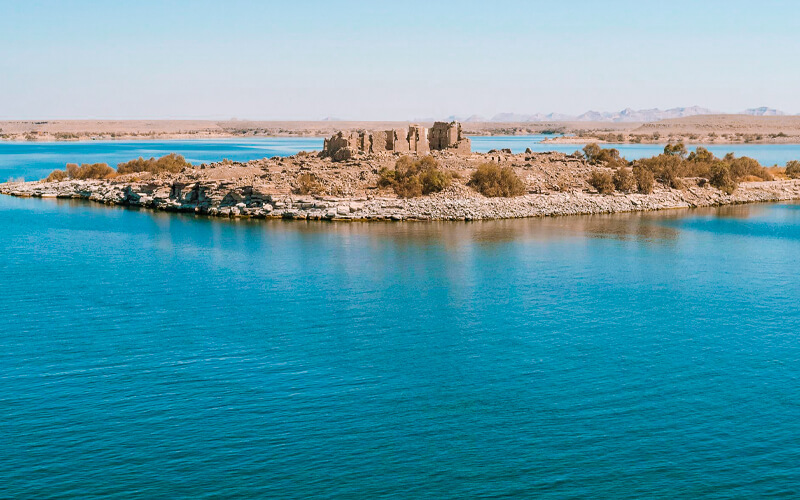Lake Nasser
Lake Nasser is a body of water in Egypt.
Lake Nasser is a massive freshwater reservoir formed by the construction of the High Dam at Aswan in the 1960s, which stretches south from the Egyptian capital of Aswan nearly 350 miles (550 kilometers) beyond Egypt’s southern border and into the Sudanese territory of northern Sudan.
The High Dam was built to replace a smaller dam that had been built by the British colonial government in 1902 but had proved insufficient for controlling the flow of the river. It was built as part of a major development initiative launched by President Gamal Abdel Nasser following the 1954 Free Officers Revolution that began in 1960 and was completed in 1970.
The dam was built to increase agricultural production and flood protection throughout the Nile Valley, as well as provide access to electricity for many of Egypt’s villages. It was completed in 1997.
Because of the increasing waters of Lake Nasser, which caused the evacuation of over 100,000 Nubian people in Egypt and northern Sudan and threatened to inundate numerous ancient structures, including the Abu Simbel temples, the dam has been contentious since its construction.
Whatever the costs or advantages of the High Dam project, the dam itself remains an outstanding technical feat, and the massive reservoir behind it supplies a rare expanse of water in the parched environment of southern Egypt.
A new industry built on fishing in Lake Nasser’s huge waters has emerged, and the growth of tourism in Egypt’s southern region has been aided by the lake. In collaboration with international groups, several of the sites that were endangered by rising waters were moved to higher land along the lake’s shores, where visitors may now readily access them by boat.
Even though the displacement of the Nubian people continues to be a contentious political subject, many of these people now reside in and around Aswan, where they can maintain their distinctive culture while earning additional revenue from tourists.
Lake Nasser serves as a tranquil gateway to the southern hemisphere. From Aswan, visitors can board Lake Nasser Nile Cruise ships that take them to the monuments along the Nile’s banks, including Philae Temple, Abu Simbel, Kalabsha Temple, Qasr Ibrim, and several others.
As a result of the dam’s construction, the lake’s waters are the only place in Egypt where one can still see the infamous Nile crocodile, as their populations below the dam have been depleted. The starkly beautiful desert scenery along the lake’s banks provides a perfect opportunity to relax while cruising the historic sites of Ancient Nubia over several days.
Lake Nasser is a great place to go fishing.
Since the completion of the dam, the waters of Lake Nasser have taken on an altogether new level of interest and fascination. Because of the depth and vastness of the lake, various kinds of fish that dwell in the Nile system have thrived and grown to incredible proportions.
Because of this, a budding sportfishing business has developed, with tourists flocking to the area in search of the opportunity to capture some of the largest freshwater fish in the world. Anglers may go on day trips with outfitters, but longer excursions are more popular since they enable the boats to reach more secluded places where they can fish privately. Both small boats and the shoreline are used for fishing in this region.
Kalabsha Temple is located in the city of Kalabsha.
The Kalabsha Temple, which is situated within sight of the High Dam, is often the first stop on any trip on Lake Nasser. Following the completion of the dam, it was relocated to this position from its original location 30 miles to the southeast.
The construction of the temple started at the end of the Ptolemaic Dynasty and was finally finished during the reign of the Roman Emperor Augustus in the first century AD. In the end, there is an intriguing blend of iconography that incorporates Egyptian and Roman motifs, with depictions of Roman emperors and pharaohs adoring the Egyptian gods as a consequence. The temple was devoted to the Nubian divinity Mandulis, who was worshiped there.
It is distinguished by a massive pylon that is linked to the rest of the complex by a wall, resulting in a contained environment. There are steps up to the roof, which provides a spectacular view of the lake and the High Dam in the distance.
The Temple of Amada is located in the city of Amada.
The Temple of Amada, located about 110 miles south of the High Dam, is the oldest of the monuments around Lake Nasser. The temple, which goes back to the 18th dynasty of the New Kingdom, predates Ramses II and Abu Simbel by around two hundred years; yet, as is characteristic of Egypt’s great pharaohs, Ramses’s mark and that of his son Merenptah can be discovered within.
Qasr Ibrim (Qasr Ibrim):
A rocky island in the center of Lake Nasser, it is a popular tourist destination. This is the sole monument on the lake’s perimeter that has survived in its original place for over a century. Qasr Ibrim was once a bustling city, but the lake drowned much of the remains, and the city was abandoned. As a result of its significance during the Middle Ages, this location is home to some of the most obvious ruins on the island, the most prominent of which are the remnants of a huge cathedral that formerly stood here. The region was occupied until the middle of the nineteenth century when it fell into neglect.
If you want to spend a fantastic vacation check out our amazing Egypt Vacation packages or Aswan Excursions to find the best way to travel to Egypt for you with Egypt Nile Cruise



